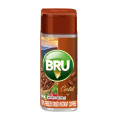 Loading... Please wait...
Loading... Please wait...- Home
- Indian Vegetables
- Fresh Ripe Mangoes 3 count -indian vegetable,USA
Fresh Ripe Mangoes 3 count -indian vegetable,USA
Product Description
Mangoes are generally sweet, although the taste and texture of the flesh varies across cultivars; some have a soft, pulpy texture similar to an overripe plum, while others are firmer, like a cantaloupe or avocado, and some may have a fibrous texture.
Mangoes are used in preserves such as moramba, amchur (dried and powdered unripe mango), and pickles, including a spicy mustard-oil pickle and alcohol. Ripe mangoes are often cut into thin layers, desiccated, folded, and then cut.
Mango is used to make juices, smoothies, ice cream, fruit bars, raspados, aguas frescas, pies, and sweet chili sauce, or mixed withchamoy, a sweet and spicy chili paste. It is popular on a stick dipped in hot chili powder and salt or as a main ingredient in fresh fruit combinations. In Central America, mango is either eaten green mixed with salt, vinegar, black pepper, and hot sauce, or ripe in various forms.
- Mangos are one of the most popular fruit in the World
- Mangos were first grown in India over 5,000 years ago
- Mango seeds traveled with humans from Asia to the Middle East, East Africa and South America beginning around 300 or 400 A.D.
- The paisley pattern, developed in India, is based on the shape of a mango
- A basket of mangos is considered a gesture of friendship in India
- Legend says that Buddha meditated under the cool shade of a mango tree
- Mangos are related to cashews and pistachios
- A mango tree can grow as tall as 100 feet
- The bark, leaves, skin and pit of the mango have been used in folk remedies for centuries
- Nutrition FactsMangosAmount Per 1 fruit without refuse (336 g)
Calories 201 -
% Daily Value* Total Fat 1.3 g 2% Saturated fat 0.3 g 1% Polyunsaturated fat 0.2 g Monounsaturated fat 0.5 g Cholesterol 0 mg 0% Sodium 3 mg 0% Potassium 564 mg 16% Total Carbohydrate 50 g 16% Dietary fiber 5 g 20% Sugar 46 g Protein 2.8 g 5% Vitamin A 72% Vitamin C 203% Calcium 3% Iron 2% Vitamin D 0% Vitamin B-6 20% Vitamin B-12 0% Magnesium 8% *Percent Daily Values are based on a 2,000 calorie diet. Your daily values may be higher or lower depending on your calorie needs.








